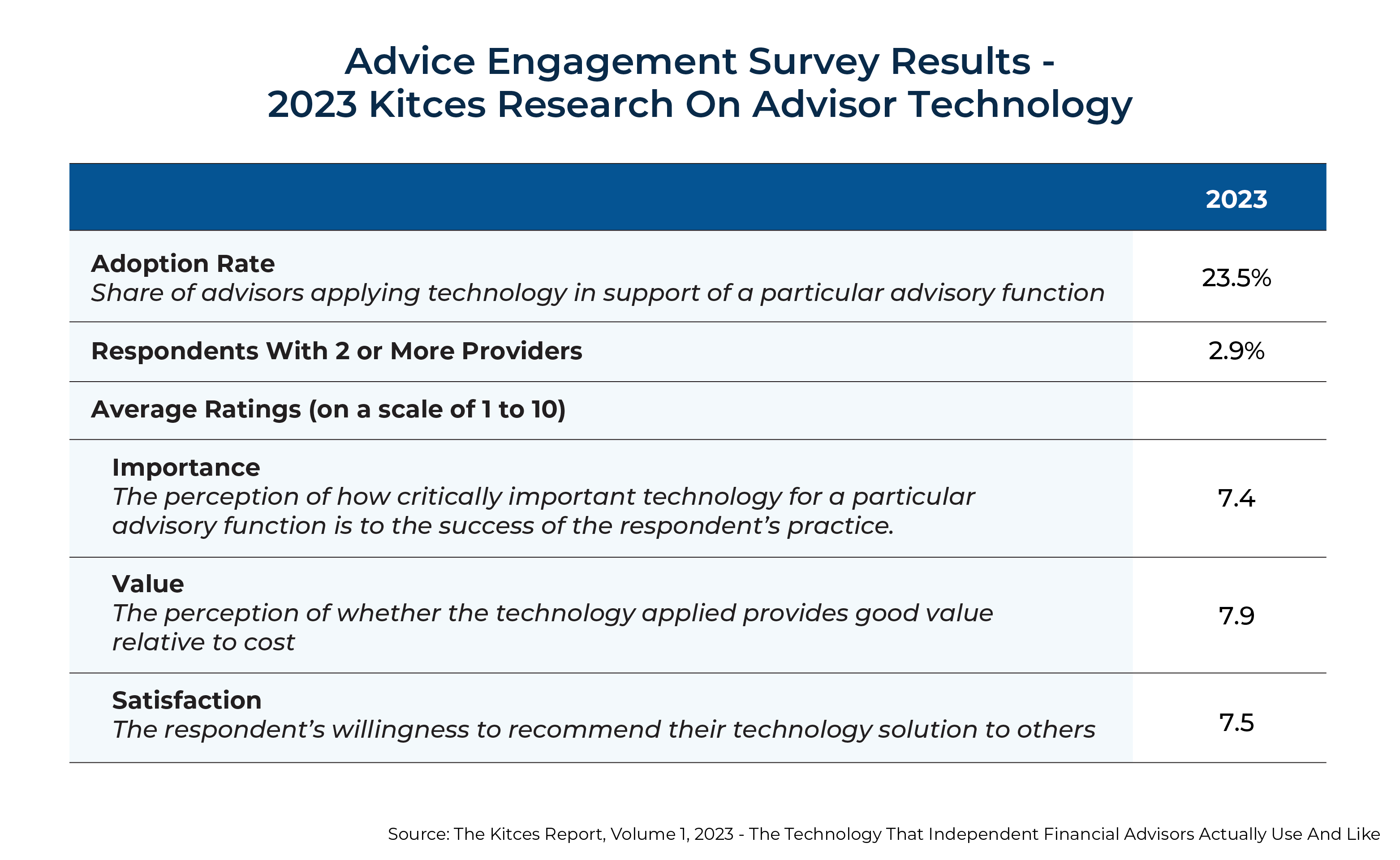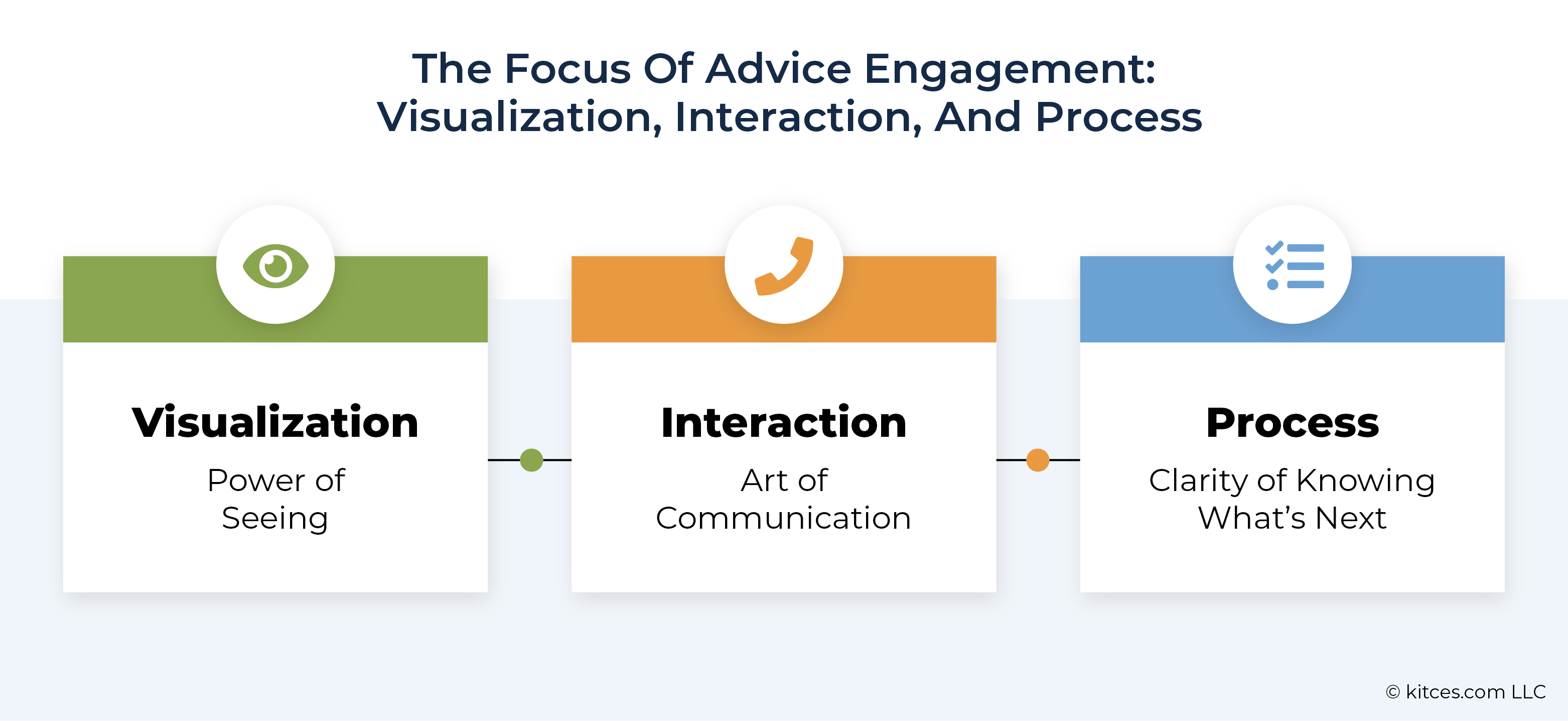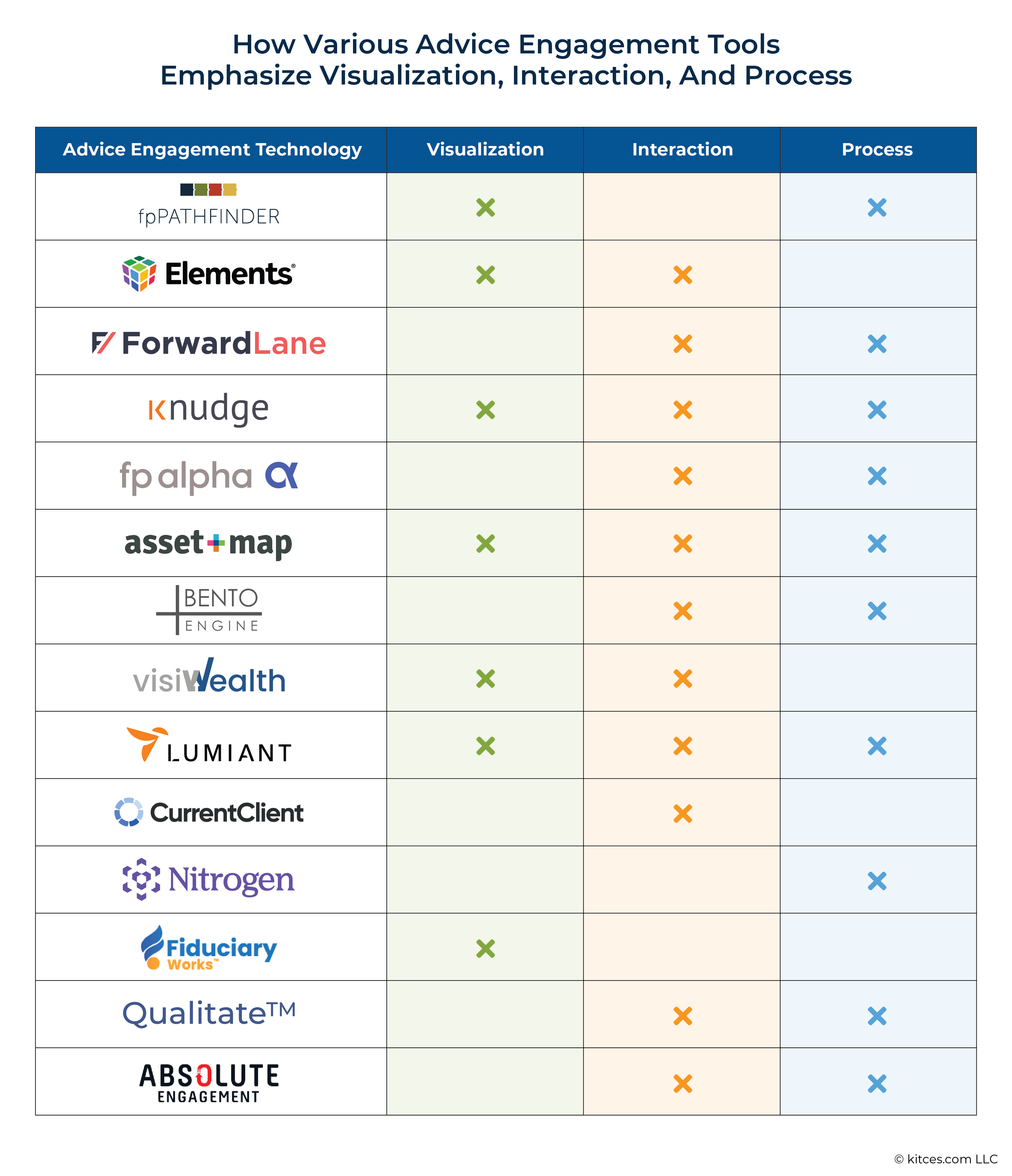Executive Summary
The traditional way that most financial planning has been offered was for an advisor to create "The Plan": a comprehensive document outlining a client's financial strategy that was delivered either on a one-time basis or updated annually. However, as the industry has shifted towards an ongoing relationship model, advisors have felt compelled to demonstrate consistent value to their clients throughout the year. The problem, however, is that a typical client's big-picture financial situation doesn't tend to change much from year to year, and the process of updating "The Plan" entails intensive document review and time-consuming data entry. Which means that updating a client's financial plan more frequently would offer little additional value to the client and would be very inefficient for the advisor.
As a result, tools have emerged that are designed to keep clients engaged in the financial planning process throughout the year, addressing the inefficiency and time burden of frequently updating the full financial plan itself. Recent Kitces Research on Advisor Technology indicates that while these newer Advice Engagement tools are not yet widely adopted among advisors (likely due at least in part to the newness of the category overall), most advisors who do use advice engagement software tend to like it – which in turn suggests that as more advisors become familiar with advice engagement tools, the rate of adoption will increase as advisors see the potential for a more dynamic ongoing financial planning process.
Broadly, advice engagement tools incorporate 3 key elements that enhance the process of financial planning: First, they use visualization tools to simplify complex and abstract financial planning concepts for clients. Second, they facilitate clear and organized communication between the advisor and client to ensure that important information is effectively conveyed. And third, advice engagement tools help clients understand where they stand in the financial planning process itself – and, most importantly, what comes next – to provide a clear roadmap and prepare the client for what lies ahead. The current tools in the Advice Engagement category vary in their use of Visualization, Interaction, and Process (VIP) elements, offering advisors the option to tailor the technology to the client experience that they desire.
Which means that for advisors considering adopting advice engagement technology, the process starts with deciding which engagement elements can do the most to enhance the advisor's existing financial planning. For many advisors, tools that help to define and navigate the planning process for clients can be the most valuable starting point, with interaction fostering more dynamic communication and visualization delivering information in an impactful, meaningful way.
Ultimately, as financial advice continues to steer away from static plans and towards a more dynamic planning relationship with clients, advisors will increasingly benefit from tools that can help them not only analyze and project financial data, but also deliver information to clients more effectively. Because as the increasing adoption and high satisfaction of advice engagement tools show, giving clients a "VIP" experience really does increase their engagement not only with the advisor, creating a deeper client-advisor relationship, but also with the financial planning process itself, making both client and advisor more successful in the long run!
In the constantly changing landscape of Advisor FinTech, advice engagement technology has been making exciting advances. As a relatively new category recently added to the Kitces.com Financial Advisor Technology Map in February 2022, advice engagement tools have been around for much longer, previously categorized as either mind-mapping tools or applications used to help advisors monitor ongoing client relationships. In fact, advice engagement is a bit of both – as described by the latest Kitces Research on Advisor Technology, advice engagement technology is used to "nudge, remind, organize, and create visuals for clients – all with the goal of having more productive conversations with clients around their advice recommendations or outright prompting clients to act on those recommendations." In essence, advice engagement fosters more interactive client relationships, motivating clients to become more active participants in the financial planning process.
Which is relevant for advisors and clients alike – because both experience frustration when a plan doesn't come to fruition. Often, the failure to implement a plan is rooted in challenges with prioritizing goals (and the tasks needed to realize them) and a lack of clarity regarding the financial planning process. To address and circumvent these challenges, advice engagement tools serve to preserve the hard work that has gone into the initial planning meetings, from creating to-do lists to exploring client-specific nuances, and to help the advisor connect with clients to ensure they actualize their plans.
Furthermore, the evolving field of financial planning is shifting away from the static comprehensive financial plan – prepared for a client once and perhaps reviewed and updated on an annual basis – and moving toward an ongoing planning approach, maintaining closer connections with clients and making more frequent updates and adjustments to their plans over time. Accordingly, advice engagement tools are growing in popularity because of their focus on client engagement in the financial planning process, making ongoing planning efforts more productive for advisors and meaningful for clients.
Client engagement is particularly relevant in the monitoring stage of financial planning, as advisors are finding better strategies and solutions that reduce the challenging problems arising from common gaps in communication – whether it's about a client forgetting to mention a significant purchase like a boat or overlooking key tasks such as updating their estate plan. Furthermore, advice engagement technology helps advisors create personalized, high-touch experiences for their clients by promoting positive human interaction and communication and deepening the advisor's value proposition.
The Advice Engagement Experience – Solutions For Advisors And Clients
The 2023 Kitces Research On Advisor Technology reveals the growing usage of advice engagement tools among financial advisors. Among the various categories surveyed, Advice Engagement has been identified as a "waxing" category, which not only indicates that advisors are satisfied with the existing tools available, but also shows promising signs of increased adoption and market share potential for established providers.
Though Advice Engagement is a relatively new category, it has demonstrated significant growth and presents a range of choices for advisors. When measured against 26 other categories, Advice Engagement shows a notably positive progression in both market value and advisor satisfaction. It's noteworthy that despite its novelty, it performs commendably in comparison to other, more established categories.
While the modest importance rating for this technology might initially seem disheartening, this perspective shifts when considering certain factors:
- The satisfaction with advice engagement tools outweighs their perceived importance, signaling a trajectory of growth. And as advisors become more acquainted with the capabilities of advice engagement technology, its adoption is anticipated to rise, potentially boosting future ratings as the benefits of advice engagement strategies become more evident.
- As a newcomer in the Advisor FinTech landscape, surveyed for the first time in 2023, Advice Engagement is not a widely known category among advisors. The current importance rating may reflect a lack of awareness among advisors more so than its actual effectiveness.
Despite these initial lukewarm results, the expectation is that as the knowledge of advice engagement tools grows, their utilization will also grow, likely enhancing the financial planning process overall. Because even though providing great financial advice is a fundamental aspect of financial planning, the best plans will fall short without client implementation.
The VIP Approach Of Advice Engagement: Visualization, Interaction, And Process
Advice Engagement makes financial planning more actionable and engaging by incorporating 3 key elements: Visualization, Interaction, and Process (VIP). Advice engagement tools are grounded in scientific principles and are demonstrably effective.
Element 1: Visualization – The Power Of Seeing
The saying "seeing is believing" holds particular relevance when it comes to clients engaging in the financial planning process. Research shows that visualizing financial data, risk, and portfolios enhances understanding and decision-making greatly, as complex and abstract financial concepts tend to be more accessible when presented visually.
And people generally feel better and more confident when they understand information presented to them, especially when it helps empower them to make informed decisions about their goals and stay actively engaged with their financial landscape.
Many advice engagement applications excel at helping advisors present data and facilitate brainstorming sessions through tools that help clients clearly understand their situation and engage them in thought-provoking dialogue to explore different approaches to successfully achieve their goals.
Element 2: Interaction – The Art Of Communication
Good communication is the cornerstone of successful client-advisor interactions. Not only is the importance of clear communication intuitively understood, but it is also backed by science; especially in financial planning, the importance of clear communication can't be overstated for clients who rely on their advisors to help them plan and achieve their most important goals.
Advice engagement tools aim to streamline, enhance, and organize communication between advisors and clients to help them foster a more productive, satisfying, and dynamic experience for both sides.
Element 3: Process – The Clarity Of Knowing What's Next
A well-structured process in financial planning is similar to a thoughtfully crafted agenda in that it sets clear expectations, highlights the relevance and importance of the topics being discussed, and prepares both clients and advisors for what lies ahead. Furthermore, explaining the financial planning process to clients in such a way that is not only rich in content but also facilitates meaningful discussion is important to help clients delineate their priorities and reduce obstacles in achieving their financial goals.
How Advice Engagement Tools Use VIP Integration To Connect Clients To The Planning Process
Engagement is the essence of doing, and that's precisely what these technologies aim to facilitate. They help everyone involved – clients and advisors alike – to feel more connected and engaged with the financial planning process. The chart below illustrates how various advice engagement tools leverage elements of the VIP experience, breaking down which applications rely on Visualization, Interaction, and Process. Notably, there are several tools that rely on multiple VIP elements, suggesting that advisors may find value in using multiple technologies to implement a powerful, comprehensive VIP experience.
And this is in agreement with what the latest Kitces Research on Advisor Technology shows. Notably, many advisors employ multiple advice engagement tools simultaneously, such as fpPathfinder for process management, CurrentClient for interactive communication, and Elements for visual aids. Each advisor can tailor their technology stack to fit their specific needs and budget constraints, optimizing the VIP experience for their clients.
Selecting the right mix of advice engagement tools can be an exhilarating yet complex experience for advisors, given the plethora of options available. This is especially true when considering the advantages of using 2 or more advice engagement tools concurrently to yield a more comprehensive experience for clients. However, it can be helpful for advisors to choose their tech stack with a strategy and mindset geared towards action and based on their particular needs to avoid becoming overwhelmed by the growing number of choices available.
Selecting and integrating new technologies doesn't have to be an all-at-once overhaul. Instead, the integration of new systems can be a gradual journey, allowing for adjustments and learning along the way. By adopting a phased approach to integrate new tech tools, advisors can ensure a seamless transition and get the most out of their advice engagement tools.
Setting Up VIP Advice Engagement Tools By Building Backwards And Aiming For PIV – Process, Interaction, Then Visualization
For advisors looking to offer a standout VIP (Visualization, Interaction, Process) experience, it's beneficial to adopt a backward PIV (Process, Interaction, Visualization) strategy. This method prioritizes establishing a robust process first, followed by fostering meaningful interaction, and culminating with impactful visualization.
This sequence ensures a structured development of a comprehensive financial planning experience, keeping advisors from becoming overwhelmed by the many advice engagement technologies available and keeping their focus on delivering value. At the same time, clients start out with a clear process outlining their journey, with subsequent interactions defining how they will collaborate throughout this journey, and using visualization tools to provide them with an engaging overview of their financial life.
This PIV approach equips advisors to present a truly complete VIP experience. It not only makes practice management more efficient but also ensures clients are actively involved and knowledgeable about their financial path. Employing the PIV strategy is a potent method for advisors to engage clients and enhance their service offerings.
Let's explore each of these advice engagement components in this order.
Process Is The Foundation Of Financial Planning
Creating a robust financial planning process is crucial and can often be a complex task involving the transformation of routine actions into a well-documented, efficient system. A good process not only streamlines internal operations but also sets transparent expectations for clients. Research conducted by Bento Engine highlights common gaps in proactive advice for predictable client events, such as catch-up contribution eligibility or Qualified Charitable Distributions.
By integrating tools that reinforce a strong process, advisors can ensure that critical financial planning elements are not overlooked. This approach positions advisors to offer proactive, attentive service, transforming complex financial planning into an efficient and client-friendly experience. Establishing a solid process is the first step in crafting a VIP experience, enhancing both practice management and client awareness of the ongoing advisory efforts.
Interaction Is At The Heart Of Client Relationships
 The interaction between an advisor and a client can be pivotal in establishing and building the relationship, directly influencing the effectiveness of financial advice. As highlighted in Moira Somers's book, Advice That Sticks, the quality of the advisor-client relationship is crucial; advice delivered through strong, transparent interactions is more likely to be embraced and valued.
The interaction between an advisor and a client can be pivotal in establishing and building the relationship, directly influencing the effectiveness of financial advice. As highlighted in Moira Somers's book, Advice That Sticks, the quality of the advisor-client relationship is crucial; advice delivered through strong, transparent interactions is more likely to be embraced and valued.
When selecting technology to support interaction, advisors should consider when more interaction would be most beneficial. Some tools, like Absolute Engagement, offer solutions tailored to different stages of the client relationship. Others, such as Knudge – with which Somers plays a key role in behavioral strategy – focus on motivating client action, particularly in ongoing plan implementation and monitoring. Most importantly, the technology that advisors choose to help them enhance their client interactions should align with their business model and the desired depth of client engagement.
Visualization Brings Financial Data To Life
Visualization, though the final step in the PIV model, is essential in bringing a financial plan to life. It's a bit like 'icing on the cake', making abstract financial concepts tangible and understandable. Real-time visualization tools empower clients to actively engage with their finances, seeing their data, goals, and progress in a clear, visual format.
When choosing advice engagement tools that focus on visualization strategies, advisors can specifically consider what they want to help their clients visualize. This could be influenced by the advisor's niche and target client – both of these factors will impact the types of information that are most relevant and interesting to the client.
Ultimately, whether clients value seeing real-time account balances or prefer an integrated view of their financial landscape, the choice of tool should reflect the client's needs and motivate them to take action. Incorporating client feedback in this decision – perhaps through a quick survey asking clients for their feedback about the firm's decision to acquire new technology – demonstrates an advisor's dedication to providing a personalized and effective advisory experience, as well as their commitment to staying abreast of new technology.
The growing awareness of advice engagement technology marks a significant shift in the industry, steering away from traditional plan-centric approaches to a more dynamic, client-focused model. This evolution comes with a heightened focus on robust advisor-client relationships and the availability and adoption of sophisticated implementation tools that support those relationships.
For advisors seeking to implement advice engagement technology into their practice, the journey begins with establishing a solid process, as a well-defined process is the backbone of efficiency and clarity in financial planning. Following this, the focus shifts to interaction. Recognizing that advisors and their clients have unique needs, selecting advice engagement tools that reinforce meaningful interaction should be a thoughtful decision aimed at enhancing communication in ways most relevant to the advisor's practice.
Finally, visualization tools are an integral component that should not be underestimated. Visualization not only aids in comprehension but also adds a layer of personalization to the financial planning experience. And when combined with a streamlined process and tailored interaction that encourages client engagement, visualization completes the VIP experience that clients both desire and value.
In embracing these technological advancements, financial advisors are not just adopting new tools; they are stepping into a future where personalized, dynamic advice takes the forefront, innovating how financial planning is perceived and delivered!







